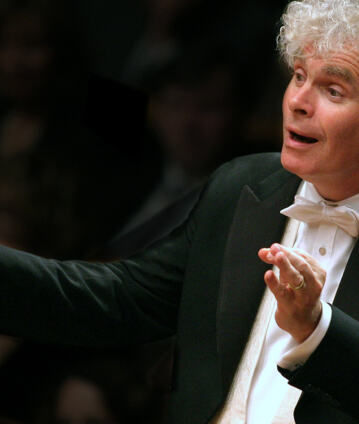Sir Simon Rattle and Miklós Perényi

The 20th century was rich in ingeniously conceived music. However, there were fewer works whose substance unfolds in a playful rather than intellectual way which, although intellectually stimulating, also sound sensuous and spontaneous. Here, Simon Rattle presents two such precious creations: Dutilleux’s Métaboles and Lutosławski’s Cello Concerto with Miklós Perényi as the soloist. The concert closes with Robert Schumann’s Second Symphony.
With Métaboles, Henri Dutilleux created a set of variations of brilliantly orchestrated orchestra pieces in which the maverick and grand old man of French modernism kept “pondering the mysterious and fascinating world of continual transformations”. In terms of construction, the work, composed in 1964 and commissioned by the Cleveland Orchestra, is a virtuoso concerto for orchestra in which the various instrumental sections (woodwinds, strings, brass and percussion) consecutively come to the fore.
In Witold Lutosławski’s cello concerto, in which the Hungarian cello virtuoso Miklós Perényi is the soloist, the cellist is, in contrast, the protagonist of the musical events. The piece, which shimmers between impressionist scintillation and expressive outbursts, by a composer who was stigmatised as a formalist in Stalinist Poland, addresses the relationship between the individual and society “in a kind of duel” (Lutosławski) where the outcome seems open. In contrast, the interplay of the varying musical forces in Schumann’s Second Symphony reaches its triumphal conclusion in the finale.
In the process, the manifold musical ideas of that movement, as Ernst Gottschald already rightly observed in the Neue Zeitschrift für Musik, “are linked together with an intrinsic spiritual bond.” So it comes as no surprise that Schumann’s contemporaries – after the successful premiere of the work on 5 November 1846 – declared him the worthy successor to Beethoven.
© 2013 Berlin Phil Media GmbH
Related interviews
Artists
Our recommendations
- Peter Eötvös conducts the premiere of his Cello Concerto Grosso
- Simon Rattle conducts the 2015 Europakonzert in Athens
- Simon Rattle conducts Bernstein’s “Wonderful Town” at the 2002 New Year’s Eve Concert
- Sir Simon Rattle conducts Mozart in Lucerne
- Simon Rattle conducts “Bluebeard’s Castle”
- Fourth concert in the Brahms/Schumann cycle with Simon Rattle